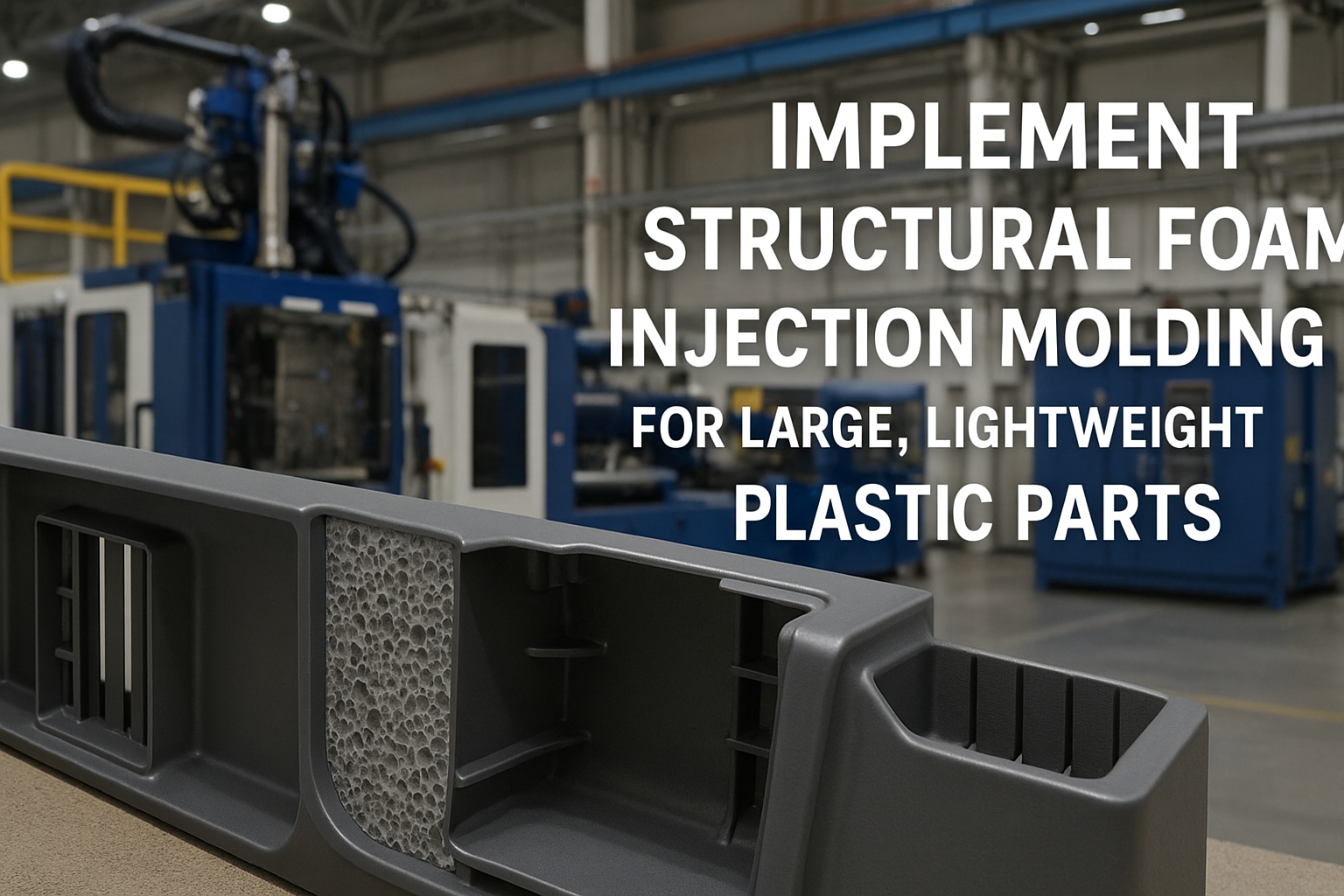Implement structural foam injection molding for large, lightweight plastic parts
Implement structural foam injection molding for large, lightweight plastic parts
When a part is too big for standard injection molding yet must be lighter than sheet-metal and stiffer than thin-wall plastics, structural foam injection molding (SFIM) can be the sweet-spot process. By introducing a chemical or physical blowing agent into the melt, SFIM creates a stiff “sandwich” structure: a rigid, micro-cellular core surrounded by a hard, solid skin. The result is large, warp-free components with impressive strength-to-weight ratios—perfect for appliance cabinets, equipment covers, material-handling totes, and outdoor housings.
1 Why Choose Structural Foam?
| Advantage | Typical Gain vs. Solid Molding | Impact on Your Project |
|---|---|---|
| Weight Reduction | 15 – 25 % lower density | Easier handling, lower shipping costs |
| Warp / Sink Control | 90 % fewer sink marks | Improved cosmetic quality—even in 8–12 mm walls |
| Stiffness & Strength | 2 × moment of inertia of solid | Long-span panels resist deflection without ribs |
| Lower Clamp Tonnage | 30 – 60 % reduction | Run big parts on smaller presses; cheaper hourly rates |
| Single-Piece Designs | Part size > 1 m possible | Consolidate multi-part assemblies; fewer fasteners |
2 How Structural Foam Works
-
Blowing Agent Added – Either a chemical foaming agent (CFA) pellet or super-critical nitrogen/CO₂ is metered into the plastic melt.
-
Low-Pressure Injection – The polymer-gas solution fills 60–80 % of the cavity volume at ~3–7 MPa (vs. 80–150 MPa for solid molding).
-
Cell Expansion & Packing – Gas expands, packing out features and forming a fine, closed-cell core while the outer skin freezes against the mold.
-
Cooling & Ejection – Thicker walls cool without sink or warp because internal foaming pressure counteracts shrinkage.
3 Design Guidelines for SFIM
| Feature / Rule | Recommended Value (PP/HDPE example) | Reason |
|---|---|---|
| Wall Thickness | 5 – 15 mm (uniform ± 20 %) | Foaming equalizes density; avoids excessive core void |
| Ribs & Bosses | 0.8 × wall for ribs; minimize bosses | Bulk stiffness comes from wall; ribs optional |
| Draft | ≥ 2° | Low-pressure fill + thicker walls need more release |
| Texturing | Medium (VDI 18–24) masks swirl marks | Skin may show “swirl” pattern; texture hides it |
| Gating | Large edge or sprue gate | Maintains melt-foam mix; hot-runner not required |
| Vent Depth / Land | 0.05 – 0.08 mm / 3 mm land | Allows gas to escape without flash |
4 Material Options
| Resin Family | Typical Grades | Notes |
|---|---|---|
| Polyolefins | HDPE, PP-copo | Cost-effective; outdoor enclosures, pallets |
| PC / PC-ABS | Low-pressure foam grades | Stiff skins; appliance doors, kiosk housings |
| Nylon (PA66-GF) | 25–30 % glass-filled | Structural machine guards, automotive load floors |
| PPE / PPE-HIPS | High heat + good flow | Electrical cabinets needing UL94 V-0 |
Suppliers offer built-in CFA masterbatches or tailor physical-foam parameters for super-critical gas systems.
5 Cost & Press Sizing Snapshot
| Metric | Solid Molding (ABS) | Structural Foam (PP-copo) |
|---|---|---|
| Part Size | 650 × 450 × 80 mm | Same |
| Wall Thickness | 3 mm | 8 mm (lighter) |
| Clamp Tonnage Required | 1 200 t | 600 t |
| Cycle Time | 85 s | 65 s |
| Part Weight | 2.2 kg | 1.7 kg (-23 %) |
| Unit Cost @ 5 000 pcs | US $9.80 | US $7.10 (-28 %) |
6 Quality & Validation Checklist
-
Cell Density & Distribution – Cut cross-section coupons; aim for 5–10 cells/mm² with uniform spread.
-
Skin Thickness – 0.5–1 mm solid skin measured by ultrasound or microtome.
-
Mechanical Testing – Flexural modulus & impact per ASTM D790 / D256.
-
Color & Swirl Control – Approve texture chips; swirl is cosmetic, not structural.
-
Dimensional CpK – Target ≥ 1.33 on fit-critical datums; low pressure often improves repeatability.
7 When SFIM Is Not Ideal
| Limitation | Better Option |
|---|---|
| Parts under 500 g or wall < 3 mm | Conventional injection molding |
| Glass-clear aesthetics needed | Solid PMMA or PC, then hard-coat |
| Tight GD&T < 0.2 mm over 300 mm | Structural foam may vary ± 0.3 mm |
| Production > 200 000 pcs/yr needing glossy Class-A | Rapid-heat-cool solid molding |
8 Why Work With TaiwanMoldMaker.com for Structural Foam
-
Low-Pressure Press Fleet — Up to 3 000 t clamps with nitrogen or CFA dosing.
-
Aluminum & Hybrid Tools — Lighter molds shave 25 % off build schedule.
-
Material Library — 300+ foam-grade PP, HDPE, PC/ABS, PA stocked locally.
-
Process Simulation — Moldflow Structural Foam module predicts cell size, clamp force, and warp.
-
Integrated Secondary Ops — CNC trimming, EMI shielding, and inline UV-printing without extra freight.
9 Implementation Roadmap
-
Upload CAD + Load Specs → receive feasibility & cost study in 48 h.
-
Approve Gate & Wall Strategy → confirm texture and swirl acceptance.
-
Prototype Aluminum Foam Tool → T-samples in 3 – 4 weeks.
-
DOE & Validation → optimize gas dosage, cycle, and cooling.
-
Bridge or Full Production → scale on 600–3 000 t presses with VMI delivery.
Key Takeaways
-
Structural foam delivers light, stiff, large parts while trimming press tonnage and cycle time.
-
Correct wall design, gating, and texture are critical to hide cosmetic swirl and ensure uniform cell structure.
-
TaiwanMoldMaker.com offers low-pressure expertise, rapid tooling, and material choice so you can deploy SFIM confidently on your next oversized enclosure or load-bearing panel.
Ready to make big, lightweight parts without blowing the budget—or your production schedule? Submit your project to TaiwanMoldMaker.com for a fast, no-obligation structural-foam quote and DFM review.









